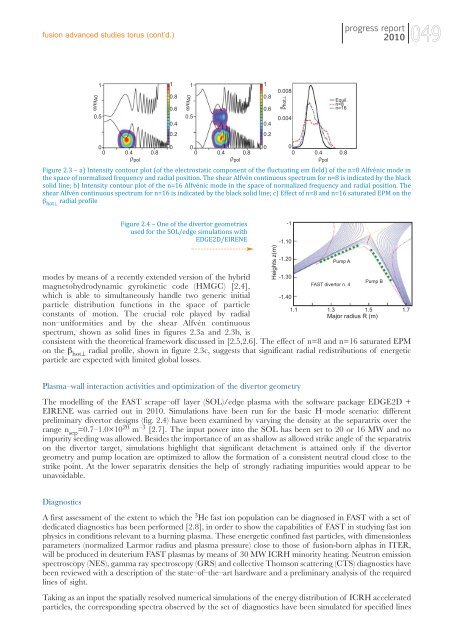Prime pagine RA2010FUS:Copia di Layout 1 - ENEA - Fusione
Prime pagine RA2010FUS:Copia di Layout 1 - ENEA - Fusione
Prime pagine RA2010FUS:Copia di Layout 1 - ENEA - Fusione
You also want an ePaper? Increase the reach of your titles
YUMPU automatically turns print PDFs into web optimized ePapers that Google loves.
fusion advanced stu<strong>di</strong>es torus (cont’d.)<br />
progress report<br />
2010<br />
049<br />
ω/ωA0<br />
1<br />
0.5<br />
1<br />
0.8<br />
0.6<br />
0.4<br />
ω/ω A0<br />
1<br />
0.5<br />
1<br />
0.8<br />
0.6<br />
0.4<br />
0.008<br />
β hot⊥<br />
0.004<br />
Equil.<br />
n=8<br />
n=16<br />
0.2<br />
0.2<br />
0<br />
0 0<br />
0 0<br />
0 0.4 0.8 0 0.4 0.8 0<br />
ρ pol<br />
ρ pol<br />
0.4 0.8<br />
ρ pol<br />
Figure 2.3 – a) Intensity contour plot (of the electrostatic component of the fluctuating em field) of the n=8 Alfvénic mode in<br />
the space of normalized frequency and ra<strong>di</strong>al position. The shear Alfvén continuous spectrum for n=8 is in<strong>di</strong>cated by the black<br />
solid line; b) Intensity contour plot of the n=16 Alfvénic mode in the space of normalized frequency and ra<strong>di</strong>al position. The<br />
shear Alfvén continuous spectrum for n=16 is in<strong>di</strong>cated by the black solid line; c) Effect of n=8 and n=16 saturated EPM on the<br />
β hot⊥ ra<strong>di</strong>al profile<br />
Figure 2.4 – One of the <strong>di</strong>vertor geometries<br />
used for the SOL/edge simulations with<br />
EDGE2D/EIRENE<br />
modes by means of a recently extended version of the hybrid<br />
-1.30<br />
Pump B<br />
FAST <strong>di</strong>vertor n. 4<br />
magnetohydrodynamic gyrokinetic code (HMGC) [2.4],<br />
which is able to simultaneously handle two generic initial<br />
-1.40<br />
particle <strong>di</strong>stribution functions in the space of particle<br />
1.1 1.3 1.5 1.7<br />
constants of motion. The crucial role played by ra<strong>di</strong>al<br />
Major ra<strong>di</strong>us R (m)<br />
non–uniformities and by the shear Alfvén continuous<br />
spectrum, shown as solid lines in figures 2.3a and 2.3b, is<br />
consistent with the theoretical framework <strong>di</strong>scussed in [2.5,2.6]. The effect of n=8 and n=16 saturated EPM<br />
on the β hot⊥<br />
ra<strong>di</strong>al profile, shown in figure 2.3c, suggests that significant ra<strong>di</strong>al re<strong>di</strong>stributions of energetic<br />
particle are expected with limited global losses.<br />
Heights z(m)<br />
-1<br />
-1.10<br />
-1.20<br />
Pump A<br />
Plasma–wall interaction activities and optimization of the <strong>di</strong>vertor geometry<br />
The modelling of the FAST scrape–off layer (SOL)/edge plasma with the software package EDGE2D +<br />
EIRENE was carried out in 2010. Simulations have been run for the basic H–mode scenario: <strong>di</strong>fferent<br />
preliminary <strong>di</strong>vertor designs (fig. 2.4) have been examined by varying the density at the separatrix over the<br />
range n sep<br />
=0.7–1.0×10 20 m –3 [2.7]. The input power into the SOL has been set to 20 or 16 MW and no<br />
impurity see<strong>di</strong>ng was allowed. Besides the importance of an as shallow as allowed strike angle of the separatrix<br />
on the <strong>di</strong>vertor target, simulations highlight that significant detachment is attained only if the <strong>di</strong>vertor<br />
geometry and pump location are optimized to allow the formation of a consistent neutral cloud close to the<br />
strike point. At the lower separatrix densities the help of strongly ra<strong>di</strong>ating impurities would appear to be<br />
unavoidable.<br />
Diagnostics<br />
A first assessment of the extent to which the 3 He fast ion population can be <strong>di</strong>agnosed in FAST with a set of<br />
de<strong>di</strong>cated <strong>di</strong>agnostics has been performed [2.8], in order to show the capabilities of FAST in studying fast ion<br />
physics in con<strong>di</strong>tions relevant to a burning plasma. These energetic confined fast particles, with <strong>di</strong>mensionless<br />
parameters (normalized Larmor ra<strong>di</strong>us and plasma pressure) close to those of fusion-born alphas in ITER,<br />
will be produced in deuterium FAST plasmas by means of 30 MW ICRH minority heating. Neutron emission<br />
spectroscopy (NES), gamma ray spectroscopy (GRS) and collective Thomson scattering (CTS) <strong>di</strong>agnostics have<br />
been reviewed with a description of the state–of–the–art hardware and a preliminary analysis of the required<br />
lines of sight.<br />
Taking as an input the spatially resolved numerical simulations of the energy <strong>di</strong>stribution of ICRH accelerated<br />
particles, the correspon<strong>di</strong>ng spectra observed by the set of <strong>di</strong>agnostics have been simulated for specified lines













